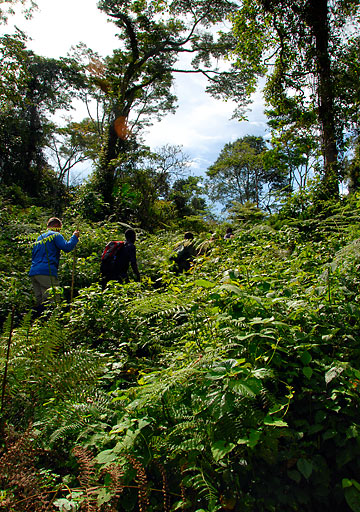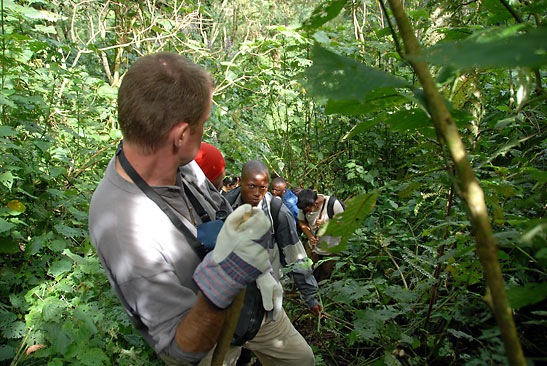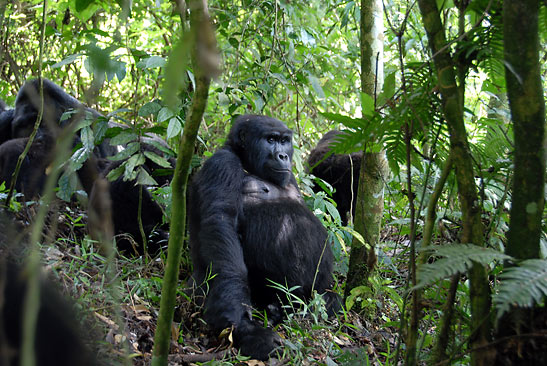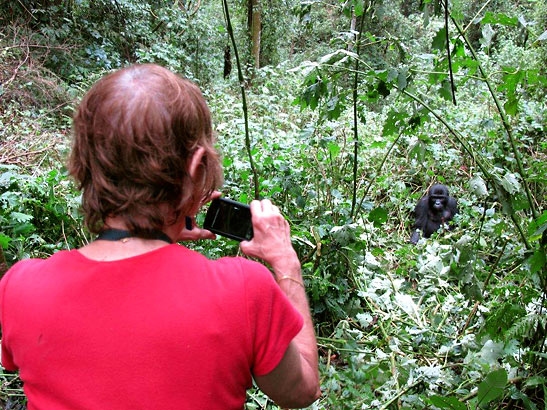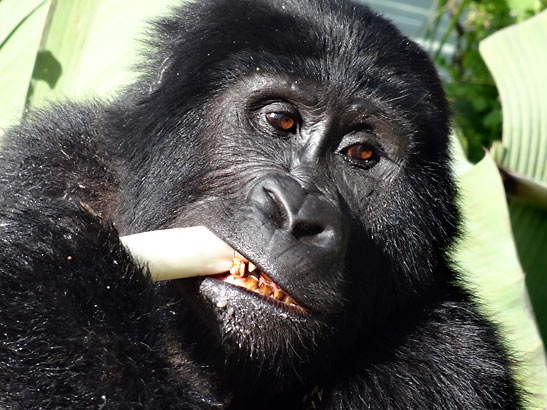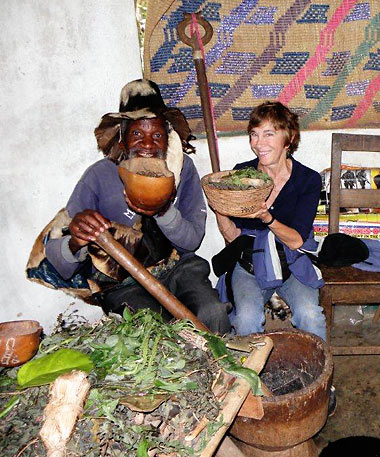 |
 |
|
 |

|
Follow the multi-adventures of Fyllis Hockman, resulting from her ElderTreks journey through southwestern Uganda, which brought her in close proximity to dozens of animals during both land and water game drives on a safari, carousing with chimps tracking through a forest, and surviving an experience of a lifetime trekking mountain gorillas. Trekking Mountain Gorillas
Still, eight humans a day are allowed to visit these gentle giants, as they are known, for no longer than an hour, as we did during a recent visit to Uganda as part of an ElderTreks tour. This is not exactly a drive-by photo op. With a vigorous (to say the least) trek of 1-7 hours, depending upon where the gorillas are that day, you have to REALLY want to see them. But even with visitation restricted to an hour, it is usually well worth the effort. But more on that later. There are about 880 mountain gorillas in the world with almost half located in Bwindi Impenetrable Forest, a World Heritage Site clearly worthy of its name, in southwestern Uganda, an 18% increase over the last census due to increased conservation efforts, education and veterinary care. This is very good news. The prelude to the hike is itself intimidating. Treks range from 1-7 hours according to the promotional material, with a maximum increase in elevation of 500 meters. Wear good hiking boots, don gloves for the nettles, a walking stick is mandatory, bring lots of water, don't get closer than 25 feet – and remember these are wild animals. Anticipation mixed closely with apprehension as every person on our tour, whether expressed aloud or not, felt "I hope I can make." The tale I'm about to tell about my travel-writing husband Vic and myself is not the norm. The tale for the other eight members of our ElderTreks tour, from whom we were separated because of the limit of eight people to a gorilla trekking group, is the opposite extreme – also not the norm. Now Vic and I, despite our somewhat advanced ages, are in pretty good shape and are avid hikers, so while nervous about the challenges ahead we were fairly confident of our ability to handle them. And we knew the porters, provided compliments of ElderTreks, were there to literally lend a hand, a shoulder, to push or pull or do whatever was necessary to get us there safely.
Boy, were we ever wrong. The trek was somewhat strenuous from the start, with steep climbs and slippery descents traversing narrow ravines, but we were holding our own, feeling pretty good about ourselves. Until we entered the forest. And there was no semblance of a trail at all. The guides were trail-blazing with the help of machetes deep into the clearly "impenetrable" woods, the rocks, roots and brambles beneath our feet not even visible because of the thick underbrush. With walking stick in one hand and the porter's in the other, I tried valiantly to move forward though at times the porter was literally dragging me up the precipitous slopes or rescuing me from sliding down sheer declines, twigs and vines attacking from both sides of the non-trail, entangling my feet and arms to further impede progress in either direction. At times, I thought either my arm would be pulled off by the porter or my legs by the vines.
All the while, I couldn't help but feel guilty for thinking to myself how little at that point I cared about the gorillas and how much I was worried about surviving the grueling trip back. I was seriously considering becoming a modern day Dian Fossey and staying with the gorillas, assuming we ever reached them, just to avoid the return trip. I wish we could say the trip was worth it but by the time we finally dragged ourselves – or more appropriately – were dragged by the porters to the designated area where the gorillas had been, they had left. This is just not what you want to hear after what several of us on the trek agreed was the most difficult thing we had ever done in our lives. Another 15 minutes down yet one more very steep embankment finally brought us into view of a couple of gorillas chowing down in the bush. Yes they were fun to see but most were hidden in the trees and bushes and admittedly for several of us though clearly not all – a younger couple was far more enthusiastic – there is very little that could have justified the arduous journey there. On the other hand, if the whole troop of gorillas were carousing about in an area where we could see them, we might have changed our minds.
But I would be remiss if I didn't recount the one highlight: All of a sudden, the mammoth silverback in front of us – the alpha male of the group – turned from chowing to charging, coming very close before the tracker waving his AK47 quickly sent him into retreat. And he – both tracker and silverback – remained immune to our pleas, now that we all had our cameras ready, to please try that again!
Did I mention that the literature says the treks can take as long as 7 hours? We left the bus at 9:30 a.m., returned at 4:30. You do the math. The rest of the tale? While Vic and I were immersed in the most harrowing experience of our lives, our eight ElderTreks traveling companions had one of the best – for which I will say they did feel a little guilty on our behalf. They related they walked along a road – repeat: road – near our lodge and within 20 minutes were in sight of their first gorilla. Another 15 minutes took them to a local farmer's banana plantation, which the 19 gorillas in the group were happily dismantling. Good for the gorillas, bad for the farmer, though the trekkers later took up a collection to compensate him. At some point, they told us sheepishly, they were totally surrounded by gorillas. So much for the 25-foot rule!
But despite those two extreme experiences, most people experience something in between that no doubt qualifies as the "experience of a lifetime" promised by the tour. "The Eldertreks Uganda trip offers the most diverse scenery and wildlife highlighted by mountain gorillas and chimps than any other country in Africa," enthused Jon Perica, an environmentalist from Northridge, California.
And it is important to note that as much as the gorilla trekking is touted as a highlight of the trip, it is only one day in a 16-day adventure that includes magnificent safari game drives on both land and water in multiple wildlife reserves, each offering different inhabitants; chimpanzee tracking that compared to the gorilla trek was a stroll through the park; unusually scenic terrain and cultural outings that ranged from meeting with members of a Pygmy tribe, a demonstration by a traditional medicine man who uses indigenous herbs to cure almost any ailment, a visit to a local school and a lunch of native Ugandan delicacies prepared by a farmer and his wife. It was an incredibly memorable trip despite our somewhat less-than-satisfactory gorilla encounter. For more information, visit eldertreks.com, which promotes "Small Group Exotic Adventures for Travelers 50 and Over." Related Articles: (Posted 5-17-2013) |
|
This site is designed and maintained by WYNK Marketing. Send all technical issues to: support@wynkmarketing.com

|











